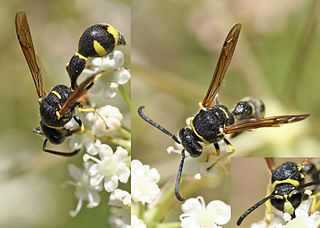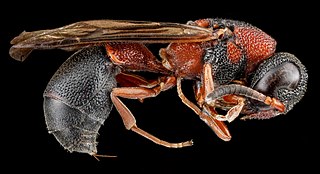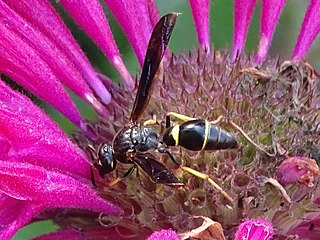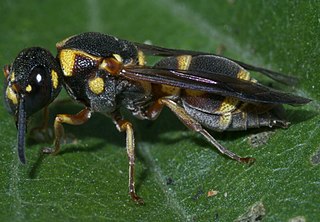
Potter wasps, the Eumeninae, are a cosmopolitan wasp group presently treated as a subfamily of Vespidae, but sometimes recognized in the past as a separate family, Eumenidae.

Eumenes is the type genus of the subfamily Eumeninae of Vespidae. It is a large and widespread genus, with over 100 taxa, mostly occurring in the temperate portions of the Northern Hemisphere. Most species are black or brown, and commonly marked with strikingly contrasting patterns of yellow, white, orange, or red. Like most vespids, their wings are folded longitudinally at rest. The first metasomal segment is narrow and elongated, creating a "bulbous" appearance to the abdomen.

Leptochilus is a large, mostly Holarctic genus of small sized potter wasps. The genus reaches its largest diversity in the Palearctic where there are more than 135 species belonging to 5 subgenera. However the division of The division of Leptochilus into subgenera can not be fully supported and the status of some of them is dubious.

Parazumia is a Neotropical and Nearctic genus of medium to large sized potter wasps. The Nearctic species of this genus have been treated for much of the 20th century as a separate genus named Paranortonia.
Pachymenes is a small but widely distributed Neotropical genus of potter wasps, it has been proposed that another Neotropical genus, Santamenes, be merged into Pachymenes.
Pachodynerus is a fairly large neotropical and nearctic genus of potter wasps with higher diversity in central South America. At least one species has been introduced in other biogeographical regions, including several oceanic islands, while Pachodynerus erynnis occurs on Ascension Island as well as in North America. This genus is most closely related to the genus Euodynerus.

Synagris is an Afrotropical genus of large potter wasps. Several Synagris wasps are strongly sexually dimorphic and males bear notable morphological secondary sexual traits including metasomal lamellar or angular protruding structures and hornlike or tusklike mandibular and/or clypeal projections.

Delta is an Old World genus of potter wasps with species predominantly distributed through tropical Africa and Asia. Some species are present in the Palearctic region, and a few have been introduced in the Nearctic and Neotropical regions. The members of this genus have a long metasomal petiole, like members of the genera Eumenes and Zeta.

Katamenes is a genus of potter wasps with species distributed in Europe and Africa. When originally named by Edmund Meade-Waldo, Katemenes was monotypic, containing only K. watsoni, but other species have since been moved from Eumenes to Katamenes.

Ropalidia is a large genus of eusocial paper wasps (Polistinae) in the tribe Ropalidiini distributed throughout the Afrotropical, Indomalayan and Australasian biogeographical regions. The genus Ropalidia is unique because it contains both independent and swarm-founding species. Ropalidia romandi is one of the swarm founding species, meaning that new nests are founded by a large group of workers with a smaller number of inseminated females, while Ropalidia revolutionalis is independent-founding, meaning that each nest is founded by a single foundress.

Stenodynerus is a rather large genus of potter wasps whose distribution spans the Nearctic, Palearctic, Oriental and Neotropical regions. Most of its species lack a transverse carina on the first metasomal tergum. A pair of medial pits on the anterior face of the pronotum and the expansion of the tegulae put this genus close to genera as Parancistrocerus, Hypancistrocerus and Eustenancistrocerus.
Knemodynerus is a genus of potter wasps distributed through the Palearctic, Afrotropical, Indomalayan and Australasian regions. The species currently classified in the genus are:
Leptomenes is a mainly Afrotropical genus of potter wasps. It was previously a much larger genus, though many species have been transferred to other genera such as Eumenidiopsis, Stroudia, and Tachymenes.

Rhynchium is an Australian, Afrotropical, Indomalayan and Palearctic genus of potter wasps.
Eustenancistrocerus is an Afrotropical, Palearctic and Oriental genus of potter wasps. The species in this genus include:
Ischnogasteroides is an Afrotropical and Palearctic genus of potter wasps. It currently includes the following species:

Oreumenes is a small Far East genus of large Eumenes-like potter wasps.
Hemipterochilus is a Palearctic genus of potter wasps. It contains the following species:
Labus is an Indomalayan genus of potter wasps. It contains the following species:

Polistes tepidus is a species of wasp in the family Vespidae. It was described by Johan Christian Fabricius in 1775. The species is endemic to parts of Oceania, primarily Indonesia, Papua New Guinea, Australia, and the Solomon Islands. Workers feed upon caterpillars to cache food for their nest. Nests are usually located in trees or other foliage but can also be found within human structures.











